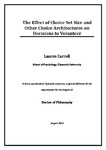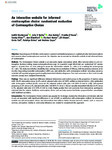The Effect of Choice Set Size and Other Choice Architectures on Decisions to Volunteer
| dc.contributor.supervisor | Pahl, Sabine | |
| dc.contributor.author | Carroll, Lauren | |
| dc.contributor.other | School of Psychology | en_US |
| dc.date.accessioned | 2014-05-13T10:03:45Z | |
| dc.date.available | 2014-05-13T10:03:45Z | |
| dc.date.issued | 2014 | |
| dc.identifier | 345923 | en_US |
| dc.identifier.uri | http://hdl.handle.net/10026.1/3003 | |
| dc.description.abstract |
This thesis adds to the existing literature on the too-much-choice effect. The effect documents a range of negative consequences as a result of choosing from extensive choice sets, such as increased decision difficulty, increased deferment likelihood, and increased feelings of uncertainty, regret and dissatisfaction with chosen options. The research presented in this thesis investigates the effect of choice amount in the novel domain of volunteering, specifically which organisation to volunteer for. This is an experiential choice rather than the material choices typically studied. The first three field studies focussed on real volunteering recruitment ‘events’ to gain preliminary insight into this new context. Study 1 demonstrated that an opt-out request for future contact consent elicited the greatest compliance. Study 2 found that only around half of the students that had intended to volunteer at the beginning of a year had done so by the end, but for those that had done so, volunteering was a positive and beneficial experience. Study 3 demonstrated the effectiveness of volunteer ‘events’ for the recruitment of volunteers, despite there being an extensive number of organisations present. Five further studies used an experimental methodology and focussed on choosing from computer based choice sets to simulate online volunteer recruitment. Study 4 found evidence of the too-much-choice effect. The greater the number of options looked at on a real volunteering website, the greater was the likelihood of decision deferment. This was mediated by decision difficulty. Study 5 replicated these findings using a more controlled experimental design and hypothetical organisations. Studies 6, 7 and 8 investigated potential choice architectural moderators of the too-much-choice effect. Option categorisation facilitated students’ decisions but not non-students (Study 6), deferment likelihood was reduced if options were presented in a ‘box’ format rather than a ‘list’ format (Study 7) and option familiarity appeared to have no effects on decisions (Study 8). Overall, this research demonstrates that extensive choice can be problematic in the novel context of volunteering and it begins to investigate choice architectures that have the potential to help people deal with extensive choice. The limitations and implications of these findings in relation to volunteer recruitment are discussed as well as possible avenues for future research. | en_US |
| dc.language.iso | en | en_US |
| dc.publisher | Plymouth University | en_US |
| dc.subject | Choice | en_US |
| dc.subject | Choice overload | en_US |
| dc.subject | Volunteering | en_US |
| dc.subject | Decision Making | en_US |
| dc.subject | Choice architectures | en_US |
| dc.subject | Volunteer recruitment | en_US |
| dc.subject | Too much choice | en_US |
| dc.title | The Effect of Choice Set Size and Other Choice Architectures on Decisions to Volunteer | en_US |
| dc.type | Thesis | |
| plymouth.version | Full version | en_US |
| dc.identifier.doi | http://dx.doi.org/10.24382/3941 | |
| dc.identifier.doi | http://dx.doi.org/10.24382/3941 |
Files in this item
This item appears in the following Collection(s)
-
01 Research Theses Main Collection
Research Theses Main



